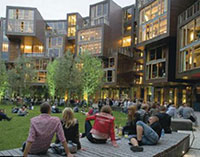An update on the tax regime for student housing, and how to achieve a zero rating
VAT and student accommodation can be a minefield for the unwary and, given most educational institutions’ adversity to incurring VAT, it is essential the position is fully understood before embarking on any student accommodation construction projects.
There have over the past few years been several changes concerning VAT and student accommodation of which providers of student accommodation should be aware.
Construction of student accommodation
Prior to 2014 the construction costs of student accommodation were zero-rated for VAT purposes (ie no VAT was chargeable on such costs) if the relevant building was to be used “solely” for a relevant residential purpose (“RRP”). HMRC interprets “solely” in these circumstances to mean that the building is to be used for at least 95% RRP use and “RRP use” includes use as accommodation for students or school pupils.
In 2014 HMRC accepted that, in certain circumstances, student accommodation could also be treated as dwellings for VAT purposes. On the face of it, this makes little difference to the VAT position on construction costs, as the construction costs of dwellings is, in the main, not subject to VAT. However, it does mean that the “change of use” provisions can be avoided.
For RRP buildings completed on or after 1 March 2011, the change of use provisions can give rise to a belated VAT cost on the previous construction of those buildings. These provisions can apply where the relevant RRP building is disposed of within 10 years following completion of construction and they apply regardless of whether the new owner’s use of the property will also be solely for an RRP. The change of use provisions therefore apply where there actually is no real change of use. The amount of VAT that can be clawed back will depend on when in the 10-year period the building is disposed of.
When the relevant building meets the conditions to be both dwellings and RRP, taxpayers can choose to rely on the VAT rules relating to either dwellings or RRP to zero rate the construction costs and, in time, to avoid the possible application of the change of use provisions.
If the property constructed has to be for an RRP use, the above trap can, with careful planning, be avoided.
Who is a student?
The relevant accommodation needs to be for students or school pupils if the construction costs are to be zero rated. HMRC considers the term “school pupil” to be “reasonably clear and uncontroversial” but in 2014 it issued a briefing on the definition of “student”.
HMRC considers a student to be “a person undertaking a course of educational study or instruction”. This covers any person who is receiving educational or vocational training from: a university or a centrally funded higher education institution; a further education institution; or any other supplier who is providing similar or the same type of education or vocational training to a similar, or the same, academic standard. People who attend classes, often badged as “summer schools”, which may offer a life-enhancing experience and promote greater cultural or spiritual awareness, the subject matter of which falls into the category of hobbies or leisure interests, will not qualify as “students”.
Care should be taken to ensure the intended occupants of the building do not jeopardise zero rating.
Use of accommodation by non-students
A lot of student accommodation is used during vacations for conferences etc to generate funds for the relevant educational institution. Prior to 1 April 2015 HMRC operated a concession referred to as the “concordat” which essentially ensured that no VAT was charged on construction costs even if the relevant building was not to be used solely for RRP use as a result of the vacation use of the building.
From 1 April 2015 this concession was withdrawn and educational institutions can now only treat accommodation as RRP if the expected use by non-students is to be confined to a couple of weeks a year.
If the relevant building meets the requirements to be classified as “dwellings”, the concession and the withdrawal of it will be of no concern as the relevant institution should be able to ensure no VAT is incurred on construction costs under the VAT rules applicable to the construction of dwellings. This is not always the case, however, as some accommodation may include non-residential elements and these will still need to rely on RRP treatment if the construction of them is to be zero rated (see below).
There are transitional rules concerning the withdrawal of the said concession that may enable the continued reliance on it for some.
Dining halls and kitchens
Prior to January 2014, under an informal concession, HMRC generally used to accept that no VAT was payable on the construction costs incurred on dining rooms and kitchens included as part of the student accommodation where the “majority” of users were resident students. This concession was withdrawn, subject to transitional rules with effect from 1 April 2015, and the position is now more restricted than it was previously.
Following the removal of the concession, education institutions and schools will only be able to avoid paying VAT on the construction of kitchens and dining halls as part of the residential accommodation constructed if the building is intended to be used solely (at least 95%) by students in that accommodation, their guests or anyone who looks after the building.
Alex Barnes is a tax partner at Irwin Mitchell








